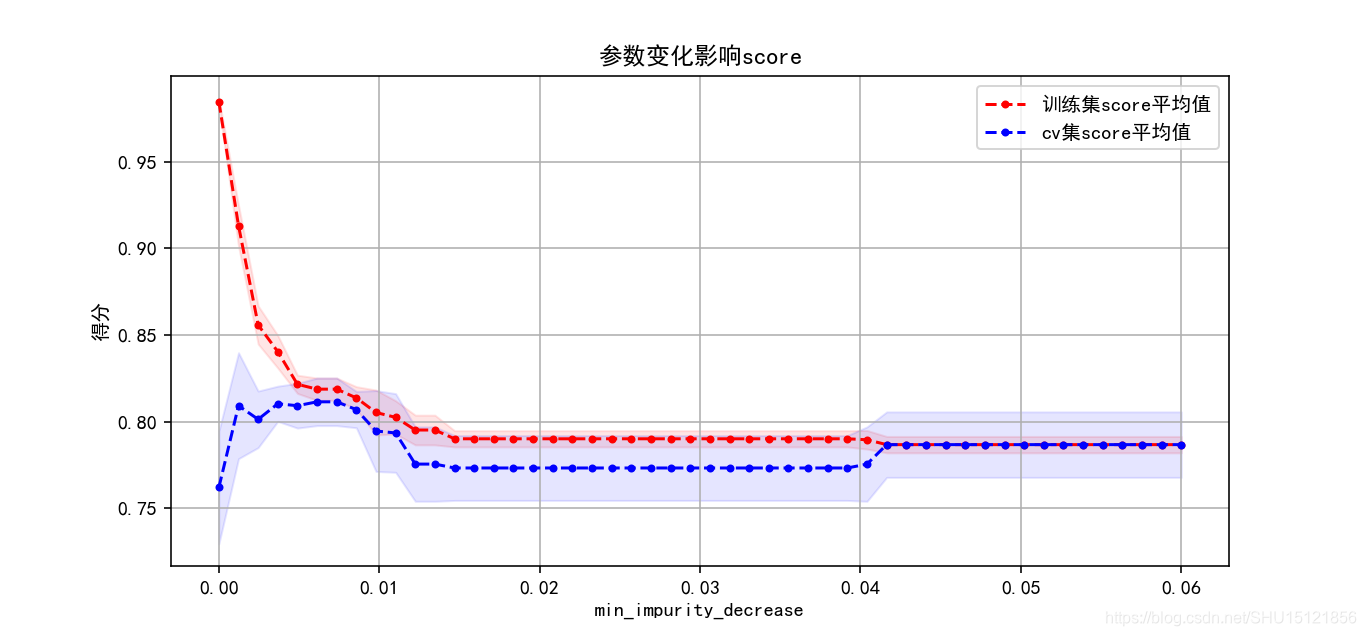【SciKit-Learn學習筆記】4:決策樹擬合泰坦尼克號資料集並提交到Kaggle
阿新 • • 發佈:2018-12-26
學習《scikit-learn機器學習》時的一些實踐。
決策樹擬合泰坦尼克號資料集
這裡用繪製引數-score曲線的方式去直觀看出模型引數對模型得分的影響,作者使用了GridSearchCV來自動做k-fold交叉驗證,並且能在多組模型引數中找到最優的一組和最優值(用平均score來評估)。
這種方式可以避免一次隨機劃分造成的不確定性太大,得到的曲線很不穩定。
import pandas as pd
import matplotlib.pyplot as plt
from sklearn.model_selection import train_test_split
import 執行結果:
最佳引數和引數值:{'min_impurity_decrease': 0.006122448979591836}
最佳得分:0.8114478114478114

--------------------多組混合--------------------
最佳引數和引數值:{'criterion': 'entropy', 'max_depth': 8, 'min_impurity_decrease': 0.0, 'min_samples_split': 22}
最佳得分:0.819304152637486
第一次提交Kaggle
在Kaggle上可以看到有三個csv檔案,除了訓練集和測試集(不帶標籤)之外,還有一個就是提交的樣本。提交的時候是提交一個和提交樣本格式一樣的csv,伺服器會根據提交的結果和測試集實際的標籤進行對比,這個問題裡是用ACC來評分的。
前面得到了最佳(其實是在給定的引數內使得cv集的平均score最高)的引數,用它來對整個樣本集擬合,然後生成模型,對測試集進行預測,然後變成指定格式的csv檔案提交即可。
import pandas as pd
from sklearn.tree import DecisionTreeClassifier
import numpy as np
BASE_DIR = "E:/WorkSpace/ReadingNotes/scikit-learn機器學習/data/"
# 讀取泰坦尼克號資料,並做一定的預處理
def read_dataset(file):
# index_col指定作為行索引的列,這裡第一列是PassengerId
df = pd.read_csv(file, index_col=0)
# 丟棄無用的特徵(指定axis=1即列),inplace=True則在df物件上操作,而不是返回操作後的df
df.drop(["Name", "Ticket", "Cabin"], axis=1, inplace=True)
# 將性別轉換為男1女0:先轉換為True/False序列再進行型別轉換
df['Sex'] = (df['Sex'] == 'male').astype('int')
# 將登船港口資料轉化為數值型資料,先獲得其中的所有可能取值放在列表中,再直接取其在列表中的下標即可
embarked_unique = df['Embarked'].unique().tolist()
df['Embarked'] = df['Embarked'].apply(lambda x: embarked_unique.index(x))
# 缺失資料(NaN)設定為0
df = df.fillna(0)
return df
if __name__ == '__main__':
with open(BASE_DIR + "z7/train.csv") as f:
df = read_dataset(f)
# 標籤即"是否存活"一列
y = df['Survived'].values
# 特徵裡要去掉標籤這一列
X = df.drop(['Survived'], axis=1).values
clf = DecisionTreeClassifier(criterion='entropy', max_depth=8, min_impurity_decrease=0.0, min_samples_split=22)
clf.fit(X, y)
print(clf.score(X, y))
# 讀入測試集並做預測,然後儲存結果
with open(BASE_DIR + "z7/test.csv") as f2:
test_df = read_dataset(f2)
predictions = clf.predict(test_df.values)
# 轉換成要求的格式
result = pd.DataFrame({'PassengerId': test_df.index, 'Survived': predictions.astype(np.int32)})
# print(result)
result.to_csv("./titanic.csv", index=False)
